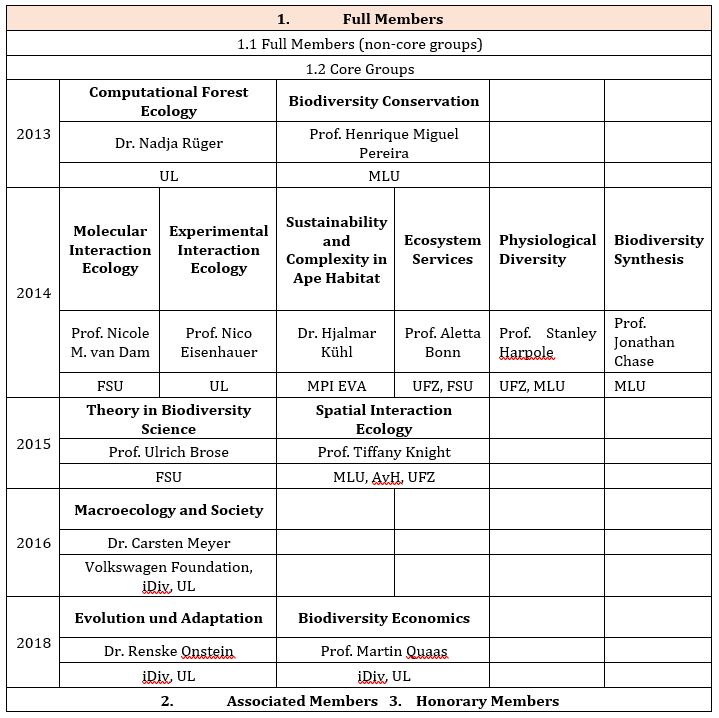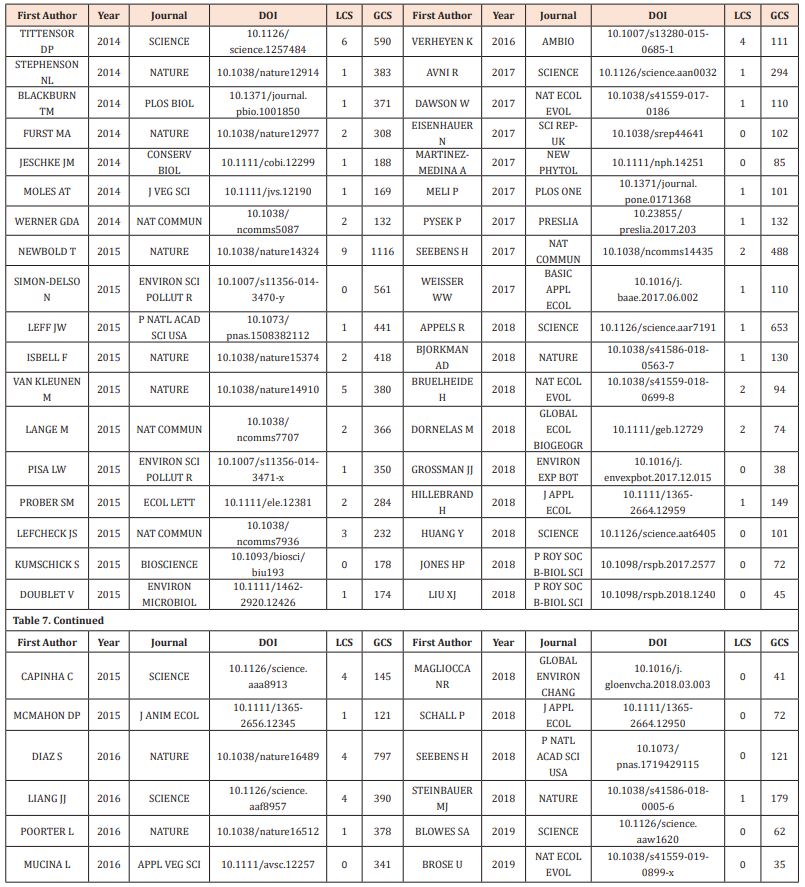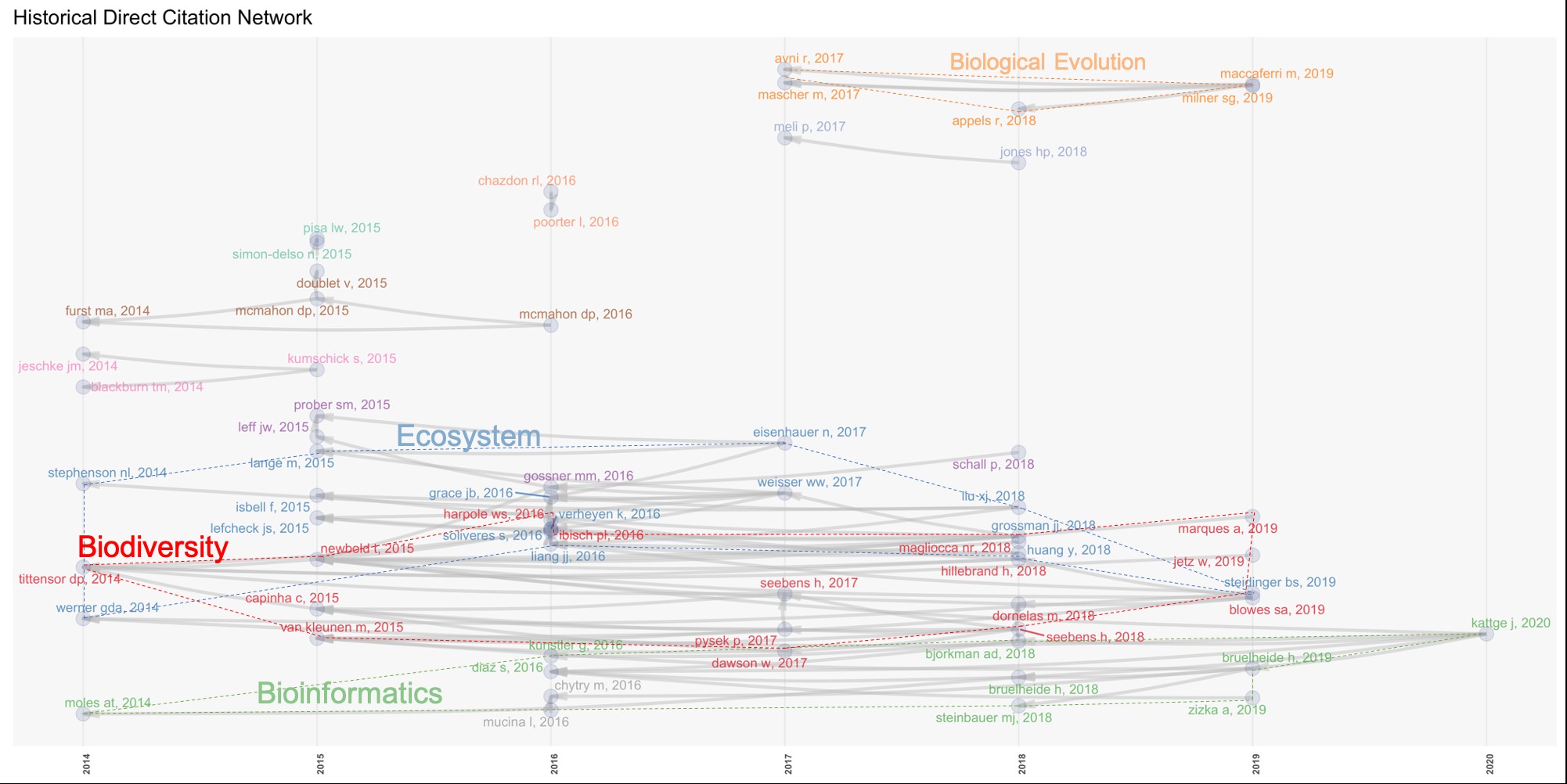Research Networks Generated by Organizational Structures, Co-Authorships and Citations: A Case Study of German Centre for Integrative Biodiversity Research (Idiv) by Zhao Qu* in
Open Access Journal of Biogeneric Science and Research
Abstract
Exploring whether different patterns emerge across networks generated by organizational structures, co-authorships and citations for characterizing and evaluating cooperative relationships is particularly important for transferring the research results into practice. This research-in-progress paper focuses on using the structure of scientific collaborations and mapping knowledge transfer to gain insight into the influence of collaborative research centres linked to the German Research Foundation (DFG) funding. Within the German Centre for Integrative Biodiversity Research (iDiv), the DFG sponsors research conducted across all participating universities and institutes by more than hundred research groups who bring their expertise to the manifold research fields of biodiversity. Using iDiv’s research from 2013-2020, we build co-authorship networks and identify the most cohesive communities in terms of collaboration and compare them with groups presented on its website. Corresponding cited and citing works are analysed by distributions to investigate the knowledge’s intellectual structure. Our findings show that the number of publications and the intensity of research collaboration have maintained a steady increase except 2018. Despite the highly cohesive cooperation structure addressed by iDiv, the internal scientific collaboration has not gained strong momentum compared with its growing trends in international collaborations. The tendency towards covering cross-disciplinary research foci is not evident.
Introduction
Cooperation between researchers, academic institutions and companies is gaining importance as research is increasingly being conducted in both homogeneous and heterogeneous collaboration contexts, including structured programs such as the collaborative research centres, and publicly funded projects between universities and companies [1-3]. The proportion of collaborative research conducted between researchers from multiple disciplines and multiple research institutions or involving non-academic partners in all fields is growing [4]. Cooperation offers great potential by linking competencies, perspectives, experiences, resources, and personalities. However, various obstacles stand in the way of fruitful cooperation in such a context. For instance, when dividing up the tasks involved in applying for a collaborative research centre, it becomes more challenging to integrate the objectives as the larger the group and the more heterogeneous the actors. The German Centre for Integrative Biodiversity Research (iDiv) offers the possibility to investigate typical problems (e.g., changing memberships, allocation of output, fluid boundaries of the working groups involved in the cooperation, the informative value of funding acknowledgements) since this DFG centre is established upon cooperation from 1995 called “Unibund”, extending the network from members based primarily in Halle, Jena and Leipzig to researchers from 30 nations. Eleven research institutions (Figure 1) joined forces to establish iDiv within the network have equal footings (S. Matthiä, personal communication, December 4, 2008). Collaborations with experts worldwide are central momentum at iDiv, and 13 core research groups have been newly established since its founding (Table 1). The composition of personnel at iDiv is somewhat complicated, with employees and members, of which the membership includes full members, associated members, and honorary members. Although there is no requirement in the cooperation agreement that the centre needs to be labelled by its members as the author's affiliation, this complex structure would significantly impact a deeper understanding of bibliometric research findings. For instance, a paper affiliated with iDiv would not necessarily imply that the author is employed by the centre, whereas the research is primarily done within iDiv. The iDiv context may refer to the physical space or the research network. A new question arises amid characterizing and evaluating cooperative relationships: whether different patterns of networks emerge between research groups generated by organizational structures and scientific collaborations?
Table 1: Members of the iDiv network.


Figure 1: Cooperation partners of the consortium.
Collaboration in groups has a long tradition in experimental sciences [5], while collaboration in research networks is a parallel and complementary to the research group in a university department or an industrial laboratory [6]. In general, research networks differ from research groups in that they offer greater flexibility and less bureaucracy. There is an increasing number of studies on scientific collaboration networks [7]. Bibliometric research of scientific collaboration has been conducted in various fields, particularly by using co-authorship data [8-12], providing a quantitative dimension of the frequency and extent of cooperation among researchers in the practice of their research. It should be considered that co-authorships do not fully represent collaborations as not all collaborations lead to co-authored publications, and not all co-authored publications are based on collaborations. However, this method has undoubtedly proven its worth, especially in combination with network analyses. Research on biodiversity, its relation to ecosystem functioning and services, and the assessment of the impacts of environmental change on biodiversity calls for an interdisciplinary perspective [13,14]. While several studies have analysed the disciplinary variety of bibliographic references in papers to express the acceptance of concepts, methods and data from other subject areas, other studies have analysed the distribution of citations received by these papers from other areas. The analysis of citations and co-citations, in both cited and citing publications, constitutes one of the main approaches to the interdisciplinary phenomenon [15,16].
This paper is an evaluation of the current state of research networks of a collaborative research centre through the analysis of articles and citations. Specifically, it aims to provide a micro-picture of networks generated by organizational structures, co-authorships and citations within iDiv, and examine the relative importance of membership in networks for individual publication output. However, it is not only the pure quantity structure of publication activities that provides information about changes, but also structural elements of publication activity. This paper addresses two main questions for exploring whether different patterns emerge across networks:1) How different are networks of cooperation bounded by membership and collaboration presented by scientific publications? Are members within a research centre/group more likely to be co-authors, or the external authors yield a higher collaboration potential? 2) Whether insights from different fields are being acknowledged with one another or are instead located in disciplinary siloes? That is, is there a growing trend towards cross-disciplinary collaboration through citation analysis of iDiv biodiversity-focused research? This special issue is a bridging effort to bring together scientific knowledge producers and network analysis by exploring the structure of collaboration in the social context. The findings may be informative in establishing, assessing, and evaluating research networks.
Data and Methods
For answering the questions addressed in this paper, bibliographic data of 2,107 journal articles identified by DOIs inserted on the website of iDiv’s research published between 2013 and 2020 are retrieved from Web of Science Core Collection coupled with network analysis of co-authorships and citations. Co-authorship networks are generally adopted to provide an overview of the critical contributors within iDiv. Collaborative activities between communities will impact the understanding of how scientific research can add value and offer insights into central issues of concern for policy and practice. Collectively, authorship and citation analyses identify the distribution and accumulation of capital that develops as the centre evolves. The iDiv’s papers herein are first analysed through annual records, source of the leading authors, and the degree of collaboration. The number of authors per article ranges from one to 728, with over 70 per cent of iDiv’s research having three to nine authors. Therefore, we use the percentage of articles with more than two authors to measure collaboration intensity. Furthermore, we use a three-fields-plot based on a Sankey diagram that visualises how journals, research topics and countries/regions are interrelated. The general bibliometric analysis also compares the whole set of cited references and citing papers with the collected publications by research area in general.
We extract the authors and affiliation information for exploring the network of actors within the iDiv research network and its corresponding influence on scientific knowledge production. The expression differences of authors at the same institution poses difficulties in the data processing of this study. We apply a thesaurus file created through a three-step process to merge 786 institutional names from 3,841 author affiliations listed in the raw data. The data cleaning tools of VantagePoint perform software cleaning. Then, parts involving problems with misspellings, language conversions and abbreviations that have not been approached (e.g., University Jene, Gottingen University or CSIC) are integrated manually. Finally, experts review the processed data to keep the names of their affiliations standardized. We employ network-clustering algorithms in VOSviewer 1.6.16 to map and analyse the patterns of corresponding networks. The structures of co-authorship networks formed by authors and institutions are further compared with groups and networks bounded by memberships within iDiv. Given the limited team size of 13 research groups, the full membership list serves as an additional basis for interpreting the co-authorship network. As this is one of the numerous case studies in the ongoing project research, we conduct a preliminary analysis of the conceptual and intellectual structures of knowledge using data extracted from 6,467 references and 17,751 citing papers as at 31.12.2020 of 106 highly cited publications within the dataset as aforesaid. A direct citation analysis develops the intellectual structure as this approach provides a more accurate representation of the taxonomy of scientific and technical knowledge. We use a historical direct citation network coupled with trend topics to visualise topics of interest and the following debate that scholars open in the scientific field.
Results and Discussion
General trends in iDiv’s research
Between 2013 and 2017, research of iDiv presented a growing trend in counts and international scientific collaborations, with minor fluctuations since 2018 (Table 2). Although the intensity of collaboration does not vary significantly from year to year, iDiv has maintained considerable momentum in international collaboration.
Table 2: Publication count and collaboration intensity by year.

The interconnections among journals, research topics and countries can provide useful insights. Hence, we present a three-fields plot in Figure 2, which shows the interactions among the most relevant publication outlets (left), author keywords (middle) and countries (right) of iDiv’s papers. Meanwhile, Table 3 presents the distribution of primary source journals by subject area. We find that studies on biodiversity mainly distribute in journal Ecology Letters, most of which are authored by German scholars. Similarly, the journal Global Change Biology has published the majority of the climate change-related studies, again mainly authored by German scholars. In general, authors from Germany and the United States have broadly investigated research topics concerning biodiversity, species richness, functional diversity, and climate change. Chinese scholars have shown a particular interest in bef-china related research. On an aggregate level, authors from European countries have a great interest in ecosystem studies. Among the journals, Ecology publishes studies in a comparatively broad range of topics including disturbance, global change, competition, and community assembly.
Table 3: Journals by subject area.


Figure 2: Three-fields plot by country, affiliation, and sources (Top 15).
There are 3,509 documents mainly with German authors of 88,538 references included in the articles of iDiv were co-cited over five times. Nearly 50 per cent of 33,272 citing papers (without self-citations) to iDiv’s research are published by authors from the United States and China. We compare the whole set of cited references, citing papers and the collected publications by research areas in general. Terms shown in blue colour in Table 4 refer to areas where both iDiv’s research and its references have explored. The parts marked in grey colour refer to the overlap in research areas between iDiv’s research and its citing papers. Nearly 90 per cent of the leading research areas covered by the three groups of publications are consistent, but with minor differences in each area's proportion. The iDiv scholars have cited works on Statistics Probability, Computer Science Interdisciplinary Applications and Cell Biology, while related topics are not explored further. Likewise, citing papers have not broadly investigated issues concerning Biochemical Research Methods, Mathematical Computational Biology and Economics. However, we can find in the distribution of research areas of the forward citations that topics not covered by the references have been extended in subsequent studies. There is a constant flow of relevant research on topics not addressed in the previously cited literature.
Table 4: Comparison of iDiv research, references and citing papers by research areas (Top 25).

Primary contributors and scientific collaboration networks
The network generated by research collaboration of iDiv is relatively broad, both in terms of the average number of authors per article (6.92) and the number of co-authors per item (12.1). We can identify the equally high rates of the collaboration of highly productive scholars and organizations in this collection, which is measured respectively by an individual author’s contributions to a published set of papers and affiliation’s total links (Table 5). The following primary authors are all full members of iDiv, while nearly half of the institutions are outside the network defined by the cooperative agreement.
Table 5: Primary contributors of iDiv’s research ranked by counts (Top 10).

The preliminary results of the network analysis reveal that there are 957 authors with more than five articles and collaborated with others at least five times. For a more straightforward layout of the network of iDiv-related scientific collaborations and to reduce the influence of multi-author articles, we used fractional counting methods to analyse co-authorship among authors with at least ten publications (Figure 3), gathering 325 authors and 13 clusters. Among of them, 11 of 13 research group leaders are scattered across eight different clusters. Close internal collaboration is identified within cluster seven generated by leaders from groups of Biodiversity Conservation, Ecosystem Services and Macroecology. However, cluster 12 dominated by the group leader of Evolutionary Ecology is more independent than the others. As the size of a node depends on the score of Avg. normalized. citation, the actors within clusters one and 11 with the research foci of Ecology and Plant Sciences correspond to relatively more citations.

Figure 3: Co-authorship collaboration network.
Following the approach outlined above, we map out networks of collaboration at the level of representative institutions coupled with an overlay visualization (Figure 4). It consists of 634 nodes and 10 clusters. The temporal distribution of collaboration indicates that the collaborative structure changed over time, from a loose interconnection of clusters to an expanded structure in terms of intensity of connection and the number of new actors joining the network. Three universities from “Unibund” (Halle – Jena – Leipzig) together with Ufz Helmholtz Ctr Environm Res as institutions joined forces to establish iDiv have also played a prominent role in the scientific collaboration shown as both maps.

Figure 4: Institutional collaboration network and an overlay visualization.
Trend topics and citation networks
References of highly cited iDiv’s papers range between 1994 and 2019, mainly including scholarly works from the United States and Germany. Respectively, citing papers from 2014 to 2020 have been broadly conducted by scholars from China and the United States. We map trend topics by author keywords extracted from highly cited research, its references and citing papers to compare the conceptual structures of knowledge, setting the parameters to a minimum word frequency of five. iDiv’s highly cited papers in the last decade have shown common interests in the topics frequently explored in cited references between 2008 and 2014, such as species richness and functional traits. Authors’ research foci in citing papers are forest management and risk assessment, while iDiv related scholars have contributed to studies on biodiversity (Figure 5).

Figure 5: Trend topics in sequence.
We employ the historiographic mapping to trace research paths and investigate the knowledge’s intellectual structure (Figure 6). Each node represents a document cited by others, and each edge represents a direct citation. The list of articles is shown in Table 6. The direction of the arrows in Figure 6 explains the chronical change of research trends from the past, steering the research paths of biodiversity, bioinformatics, ecosystem and biological evolution. For example, Tittensor [17] provided a comprehensive mid-term assessment of progress toward international biodiversity targets, and then the subsequent research discussed how biodiversity was changing by combining synthesis, theory and detection [18 -25]. This contributed to promoting articles facilitating quantitative analysis of temporal patterns of biodiversity [26-28] and research on a typology of generalized knowledge claims [29]. Recently, changes in biodiversity have been explored in a broader societal context together with economic models and human activities [30-34].
Table 6: Legend of historiographic mapping (LC: Local Citations, TC: Total Citations).



Figure6:
Conclusion
The preliminary analysis presented here suggests that the networks generated by the organizational structures, scientific collaborations and citations can potentially provide additional insight into the impact of funded collaborative centre beyond that achieved through typical analyses of the research outputs based on publication and citation count data. The number of publications and the intensity of research collaboration have maintained a steady increase since 2013. iDiv is dedicated to bringing together member institutions to cover cross-disciplinary research foci, while the internal scientific collaboration among members has not demonstrated strong momentum. Nearly 90 per cent of the leading research areas covered by cited references, citing papers and collected publications are consistent. Research paths presented by direct citation links in highly cited papers indicate the coherent research foci of iDiv on ecosystem, biodiversity and bioinformatics. Nevertheless, the strong international research collaboration developed by member institutions provides an expanding platform for knowledge production, exchange and transfer than the established organisational structure. Further research will provide a deeper understanding of whether the establishment of iDiv has strengthened the internal links between members with existing cooperation and its potential influences on the emergence of new research communities. Moreover, data retrieved from sources like funding texts and personal profiles are further coupled to explore what facilitates iDiv’s scientific research and relevant collaboration at different levels.
More information regarding this Article visit: OAJBGSR












































